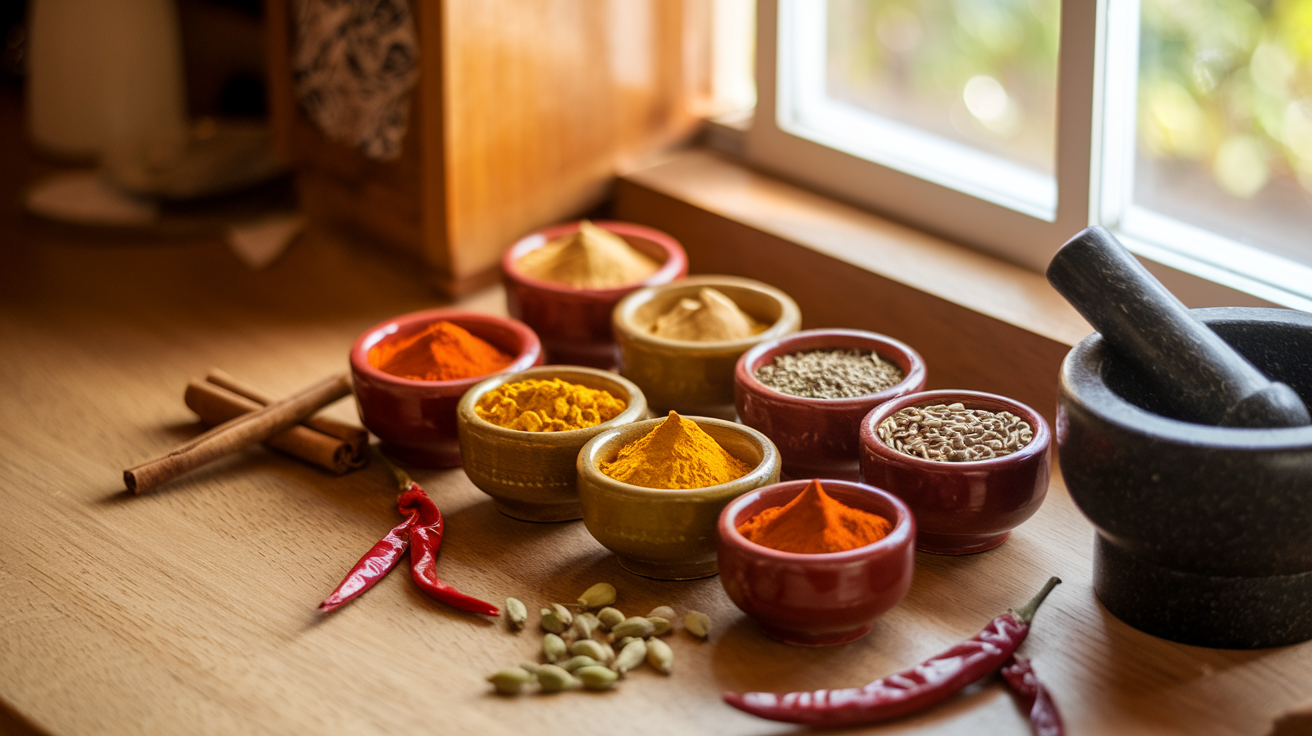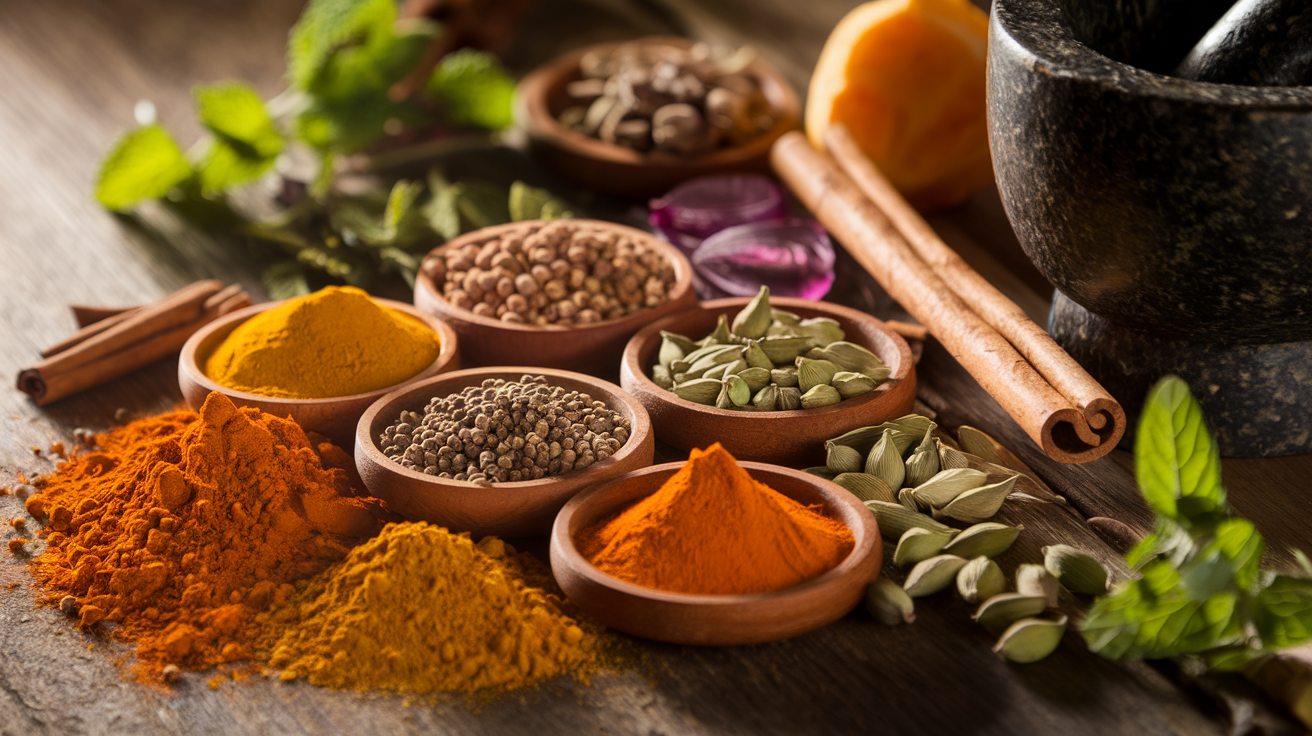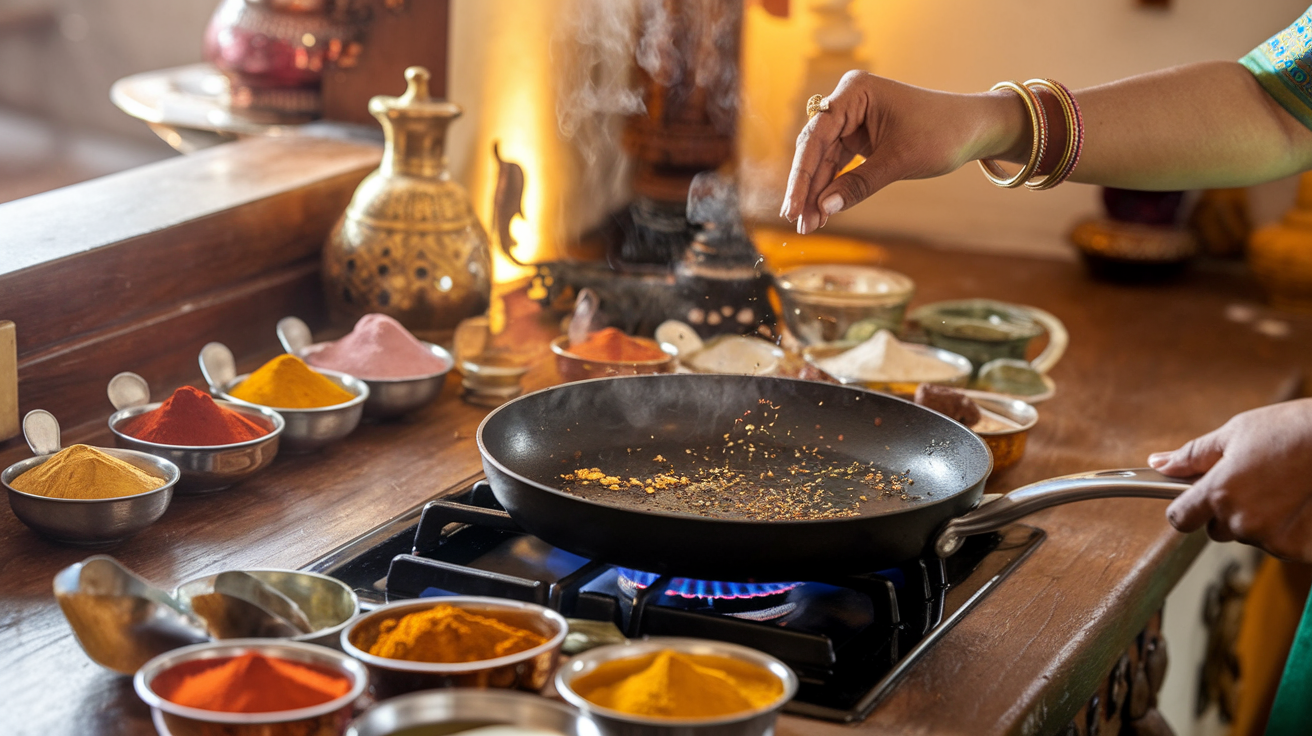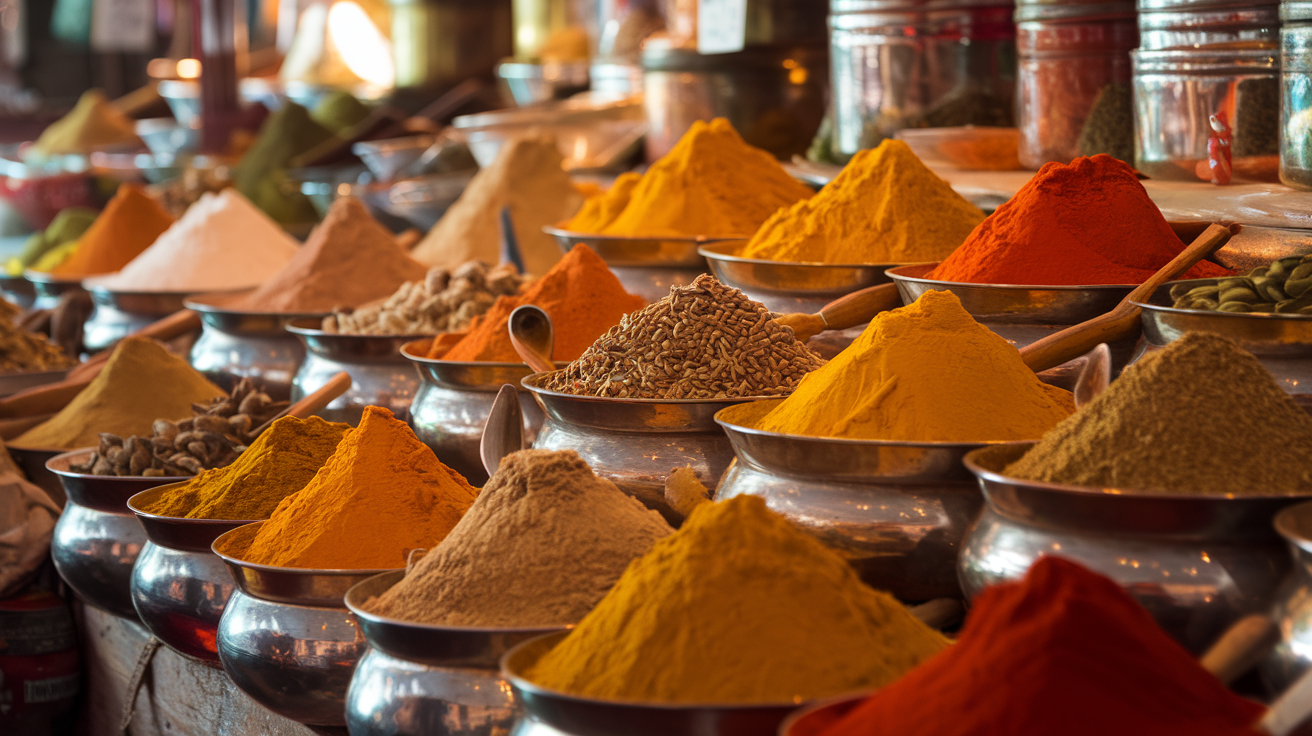
 Spice up your life!
Spice up your life! 
Have you ever walked into an Indian restaurant and been instantly captivated by the tantalizing aromas wafting through the air? Those enticing scents are the result of a carefully crafted blend of Indian spices – the secret weapon of every Indian chef. But why should restaurant chefs have all the fun? Imagine transforming your own kitchen into a fragrant oasis of exotic flavors, where every dish you create is an adventure for the senses.
The world of Indian spices is vast and colorful, with each spice telling its own story of tradition, health, and culinary magic. From the fiery heat of red chili to the warm embrace of cinnamon, these spices hold the power to elevate even the simplest of dishes. But where do you begin? How can you harness this power in your own cooking? In this blog post, we’ll unlock the secrets of Indian spices, guiding you through everything from the essential spices you need to stock your kitchen, to the incredible health benefits they offer, and even how to use them in your cooking. Get ready to embark on a flavorful journey that will forever change the way you approach your meals!
Essential Indian Spices for Your Kitchen

A. Turmeric: The Golden Healer
Turmeric, often called the “golden spice,” is a cornerstone of Indian cuisine and Ayurvedic medicine. Its vibrant yellow color and earthy flavor make it a versatile ingredient in many dishes. Let’s explore three distinctive varieties of turmeric:
1) Lakadong Turmeric
Hailing from Meghalaya, India, Lakadong turmeric is renowned for its exceptionally high curcumin content, often reaching up to 7-9%. This makes it a powerhouse of antioxidants and anti-inflammatory properties.
2) Black Turmeric
A rare variety, black turmeric is native to Northeast India. It has a more pungent aroma and a slightly bitter taste compared to its yellow counterpart. Black turmeric is prized for its medicinal properties in traditional medicine.
3) Rajapuri Turmeric
Originating from Maharashtra, Rajapuri turmeric is known for its bright yellow color and balanced flavor profile. It’s a popular choice for everyday cooking due to its versatility.
| Turmeric Variety | Origin | Curcumin Content | Flavor Profile |
|---|---|---|---|
| Lakadong | Meghalaya | 7-9% | Earthy, slightly bitter |
| Black | Northeast India | 3-5% | Pungent, bitter |
| Rajapuri | Maharashtra | 2-4% | Balanced, mildly aromatic |
B. Red Chilli: The King of Heat & Flavor
Red chillies are essential in Indian cuisine, adding both heat and depth to dishes. Here are four notable varieties:
- Bhoot Jolokia: Also known as Ghost Pepper, it’s one of the hottest chillies in the world.
- Bird’s Eye Chili: Small but potent, these chillies pack a fiery punch.
- Pure Teja Chilli: Originating from Andhra Pradesh, it offers a balanced heat and rich color.
- Kashmiri Red Chilli: Known for its vibrant color and mild heat, perfect for dishes where color is key.
Health Benefits of Indian Spices

Anti-inflammatory Properties
Many Indian spices possess potent anti-inflammatory properties, making them valuable additions to a healthy diet. Turmeric, in particular, stands out for its active compound curcumin, which has been shown to reduce inflammation in various studies.
| Spice | Key Anti-inflammatory Compound |
|---|---|
| Turmeric | Curcumin |
| Ginger | Gingerols |
| Cinnamon | Cinnamaldehyde |
| Black Pepper | Piperine |
Digestive Aid
Indian spices are renowned for their ability to support digestive health. Incorporating these spices into your meals can help:
- Stimulate digestive enzymes
- Reduce bloating and gas
- Alleviate nausea
- Promote overall gut health
Antioxidant Power
Many Indian spices are rich in antioxidants, which help protect the body from harmful free radicals. Cloves, for instance, have one of the highest antioxidant contents among spices.
Immune System Boost
Spices like ginger, garlic, and turmeric have immune-boosting properties. Regular consumption of these spices can help strengthen your body’s natural defenses against infections and diseases.
Weight Management Support
Some Indian spices may aid in weight management by:
- Boosting metabolism
- Reducing appetite
- Improving fat oxidation
For example, cayenne pepper contains capsaicin, which has been linked to increased calorie burning and reduced appetite.
Cooking with Indian Spices

Tempering Techniques
Tempering, or “tadka” in Hindi, is a crucial technique in Indian cooking that infuses dishes with rich, complex flavors. This method involves heating oil or ghee and adding spices to release their essential oils. Here’s a step-by-step guide to mastering tempering:
- Heat oil or ghee in a small pan
- Add whole spices (e.g., cumin seeds, mustard seeds)
- Wait for spices to sizzle and release aroma
- Add powdered spices if desired
- Pour the tempered mixture over the dish
Common spices used in tempering:
| Whole Spices | Powdered Spices |
|---|---|
| Cumin seeds | Turmeric |
| Mustard seeds | Red chili powder |
| Fennel seeds | Garam masala |
| Coriander seeds | Cumin powder |
Balancing Flavors in Dishes
Creating a harmonious blend of flavors is essential in Indian cuisine. The key is to balance the six primary tastes: sweet, sour, salty, bitter, pungent, and astringent. Here are some tips to achieve perfect flavor balance:
- Start with a base of aromatics (onions, garlic, ginger)
- Layer spices gradually, starting with whole spices and ending with powdered ones
- Use acidic ingredients (tomatoes, tamarind) to brighten flavors
- Add a touch of sweetness (jaggery, honey) to balance heat and acidity
- Finish with fresh herbs (cilantro, mint) for a burst of freshness
Remember, practice makes perfect when it comes to balancing flavors. Experiment with different spice combinations and ratios to find your ideal flavor profile. Next, we’ll explore how these spices vary across different regions of India, each with its unique culinary traditions.
Regional Spice Variations in Indian Cuisine

North Indian Spice Profiles
North Indian cuisine is known for its bold and aromatic spices. The region favors warm, hearty flavors that complement its rich curries and tandoori dishes. Common spices include:
- Garam masala
- Cumin
- Coriander
- Cardamom
- Cinnamon
These spices are often used in combination to create complex flavor profiles. For example, the popular Punjabi dish “Butter Chicken” incorporates a blend of these spices to achieve its signature taste.
| Spice | Flavor Profile | Common Uses |
|---|---|---|
| Garam masala | Warm, sweet | Curries, marinades |
| Cumin | Earthy, nutty | Tandoori dishes, dal |
| Coriander | Citrusy, nutty | Chutneys, spice blends |
South Indian Spice Specialties
South Indian cuisine is characterized by its use of fresh, pungent spices and coconut-based dishes. The region’s tropical climate influences its spice preferences:
- Black pepper
- Curry leaves
- Mustard seeds
- Tamarind
- Asafoetida (hing)
These spices contribute to the tangy, spicy flavors found in popular dishes like sambar and rasam.
Eastern Indian Spice Preferences
Eastern Indian cuisine, particularly Bengali cooking, is known for its subtle yet complex flavors. Key spices include:
- Panch phoron (five-spice blend)
- Nigella seeds
- Mustard oil
- Green cardamom
- Bay leaves
These spices are often used in fish curries and vegetable dishes, creating a unique flavor profile that sets Eastern Indian cuisine apart.
Western Indian Spice Combinations
Western Indian cuisine, especially Gujarati and Maharashtrian cooking, balances sweet, spicy, and sour flavors. Common spices include:
- Kokum
- Saffron
- Sesame seeds
- Dried red chilies
- Amchur (dried mango powder)
These spices are used in diverse ways, from flavoring curries to creating spice blends like the Gujarati “Dhana Jeeru.”
Now that we’ve explored the regional spice variations across India, let’s move on to the practical aspects of storing and preserving these aromatic treasures to maintain their flavors and potency.
Storing and Preserving Indian Spices

Proper Storage Containers
Selecting the right containers is crucial for maintaining the quality of your Indian spices. Opt for airtight glass jars or stainless steel containers to prevent moisture and air from compromising the flavors. Avoid plastic containers as they can absorb odors and may react with certain spices.
| Container Type | Pros | Cons |
|---|---|---|
| Glass Jars | Airtight, non-reactive, transparent | Breakable |
| Stainless Steel | Durable, non-reactive, light-proof | Not transparent |
| Plastic | Lightweight, affordable | Can absorb odors, may react with spices |
Ideal Temperature and Humidity
Store your spices in a cool, dry place away from direct sunlight. The ideal temperature range is between 50-60°F (10-15°C). High humidity can cause spices to clump and lose potency, so aim for a relative humidity below 60%.
Grinding vs. Whole Spices
-
Whole spices:
- Retain flavor longer
- Offer more versatility
- Take up more storage space
-
Ground spices:
- Convenient for quick use
- Lose potency faster
- Require less storage space
For optimal freshness, consider grinding whole spices as needed using a mortar and pestle or electric grinder.
Shelf Life and Freshness Tips
To ensure your Indian spices remain flavorful:
- Label containers with purchase dates
- Use the “first in, first out” method
- Check spices regularly for signs of spoilage
- Replace ground spices every 6-12 months
- Replace whole spices every 1-2 years
Remember, properly stored spices don’t necessarily spoil, but they do lose potency over time. Trust your senses – if a spice lacks aroma or flavor, it’s time to replace it. With these storage and preservation techniques, you’ll be able to maintain the vibrant flavors of your Indian spices for all your culinary adventures.
FAQs :
A. Which is the world’s best turmeric?
The world’s best turmeric is widely considered to be from India, specifically from the Alleppey region in Kerala. Alleppey turmeric is known for its high curcumin content, vibrant color, and superior flavor. Here’s a comparison of different turmeric varieties:
| Variety | Origin | Curcumin Content | Color |
|---|---|---|---|
| Lakadong | Meghalaya, India | 7-10% | deep golden-yellow |
| Alleppey | Kerala, India | 5-7% | Deep orange- yellow |
| Erode | Tamil Nadu, India | 2-3% | Light yellow |
| Vietnamese | Vietnam | 1-2% | Pale yellow |
B. Challenges faced by spice farmers
Spice farmers face numerous challenges in their profession:
- Climate change and unpredictable weather patterns
- Pest and disease management
- Market price fluctuations
- Limited access to modern farming techniques
- Competition from synthetic spices
C. Procedure of processing fresh turmeric to turmeric powder
The process of converting fresh turmeric to powder involves several steps:
- Harvesting and cleaning the turmeric rhizomes
- Boiling the rhizomes to soften them and remove raw odor
- Drying the boiled rhizomes in the sun or using mechanical dryers
- Polishing the dried turmeric to remove the outer skin
- Grinding the dried turmeric into a fine powder
- Sieving to ensure uniform particle size
- Packaging the powder for storage or sale
D. Which is the world’s hottest chili?
The world’s hottest chili is the Carolina Reaper, with an average heat level of 1.5 million Scoville Heat Units (SHU). Here’s a list of some of the hottest chili peppers:
- Carolina Reaper (1.5 million SHU)
- Trinidad Moruga Scorpion (1.2 million SHU)
- 7 Pot Douglah (1.0 million SHU)
- Ghost Pepper (1.0 million SHU)
- 7 Pot Primo (1.0 million SHU)
It’s important to note that these extremely hot chilies should be handled with caution and are typically used in very small quantities in cooking.

Indian spices are the heart and soul of the country’s vibrant cuisine, offering a world of flavors, aromas, and health benefits. From the essential spices that should grace every kitchen to the regional variations that make each dish unique, these aromatic ingredients are fundamental to creating authentic Indian dishes. By understanding how to cook with and store these spices properly, you can elevate your culinary creations and experience the true essence of Indian cuisine.
Embrace the rich tapestry of Indian spices in your cooking journey. Whether you’re a seasoned chef or a curious beginner, experimenting with these flavorful ingredients will not only tantalize your taste buds but also provide numerous health benefits. Start small, explore different combinations, and soon you’ll be creating mouthwatering Indian dishes that transport you to the bustling streets and fragrant kitchens of India.
“Looking for premium-quality Indian spices? Explore our collection at Shri Anikrat Export Ventures and experience authenticity in every spice.”
🔥 “If you could only use ONE spice for the rest of your life, which one would it be and why?” 🌶️💭
💬 We’d love to hear your thoughts! Drop your answer in the comments – and if you have any feedback, we truly appreciate it! 😊👇